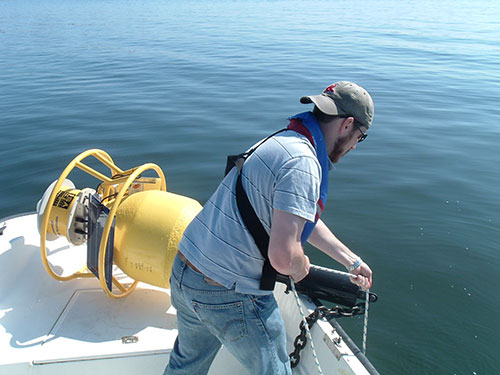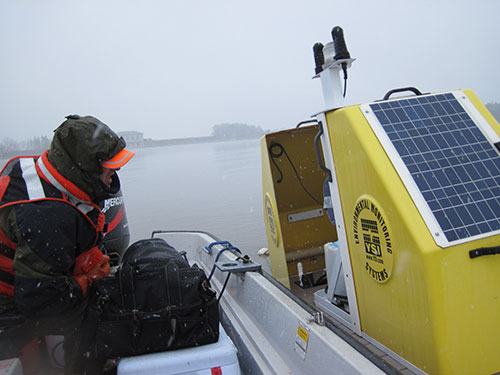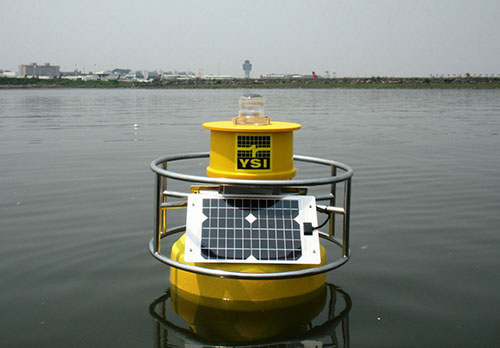Drinking Water Protected with Early Warning Systems
Water quality instruments are used for profiling and collecting baseline data to drive a better understanding of source water/drinking water characteristics. Monitoring long-term trends and changes in water quality is the first step towards a deeper understanding of source water resources.
Continuous online monitoring solutions can provide early warnings to flag filter media changes, coagulant dosing, and process adjustments for incoming algae and turbidity events. By moving toward data-driven decisions, YSI instrumentation can improve efficiency and reduce operational costs.
Beyond event monitoring, establishing baseline water quality standards has become increasingly important for protecting source water as it is affected by urbanization and agricultural changes. Continuous online monitoring is the key to understanding your source water, and it can lead to smart water management and informed decision making.
New York - Early Warning Detection for New York City
For nine million residents in New York City and four upstate counties, the quality of drinking water is of utmost importance. New York City’s Department of Environmental Protection (NYCDEP) uses YSI’s multiparameter water quality monitoring systems to ensure early warning detection. After evaluating the requirements of the NYCDEP’s water quality monitoring plan, YSI designed a system for their needs.

Buoy deployment with EXO water quality monitoring sonde
NYCDEP installed six YSI Monitoring Buoys each equipped with up to three YSI sondes. The sondes measure dissolved oxygen, conductivity, temperature, pH, and depth and are installed at different depths below the buoy. The sondes collect information that helps NYCDEP understand the dynamics of the reservoirs from top to bottom.
Each buoy is also equipped with a YSI Data Acquisition System (DAS) and a spread spectrum radio transceiver. Rechargeable batteries and solar panels assure worry-free power. The Data Loggers convert the digital outputs of the sondes to outputs that can be sent from the logger through spread spectrum radio to the SCADA system, where an operator can view and archive the information. Sondes take readings every 30 minutes and real-time information is downloaded and analyzed, providing water quality managers with the limnological data needed to assess conditions and make the best operational decisions. Data will be transmitted to the SCADA system with the potential to send alarms and alert conditions if the water quality is outside established parameters.

Monitoring platform being inspected during a beautiful winter day
Alabama - Intake Station Upgrades to Multiparameter Monitoring Equipment
In Birmingham, at the Mulberry Intake Station, raw water is pumped from the Black Warrior River and transported 22 miles downstream to the Water Works Filtration Plant for treatment. Greg Henslee, Pump Station Supervisor, wanted to upgrade his water quality monitoring equipment from single parameter monitoring equipment to multiparameter monitoring equipment that would continuously monitor and work in a 4-20 mA environment. Henslee had been using three separate instruments; a pH instrument in sampling mode, and DO and turbidity instruments in continuous mode.
Now, the YSI multiparameter sonde monitors all these parameters simultaneously. The YSI sonde is configured to continuously monitor DO, conductivity, temperature, pH, and turbidity, but could measure more than 15 parameters simultaneously. Additionally, he is converting the digital signal from the YSI sonde to an analog signal which is then tied into their plant SCADA system. Henslee can now monitor the results from his office and based on changes in water quality, can make decisions on whether or not to pump water from the Mulberry intake or another intake.
Wyoming - Source Water Fluctuations Tracked Long-Term
The City of Cheyenne, Wyoming wanted to collect long-term trend data to track and record fluctuations in their source water. Previously, someone had to drive twenty miles from the plant building to the intake site once a week to collect spot data. “Now I can pull up real-time data from twenty miles away,” said Lab Coordinator Rosie Pindilli. Cheyenne uses a YSI multiparameter sonde in conjunction with its SCADA system. Suspended in the lake, the sonde measures pH, dissolved oxygen, conductivity, turbidity, and temperature at the bottom of the dam. Lab personnel can read real-time data as often as once a minute from the front of the environmental process monitor, which has a large clear display; or they have the option to view the data from the SCADA system or a PC.
The monitor’s four scalable relays can drive several functions including alarm indicators such as lamps, horns, or an automatic phone dialer system that are activated at user-defined set points. The Cheyenne treatment plant uses maximum or minimum values for all five parameters to trigger its alarms.
Georgia - Source Water Assessment and Protection
The Columbus Water Works has initiated a regional watershed program involving both water quality and drinking water protection. The source water protection program element of the Middle Chattahoochee River Watershed Study is a demonstration program supported by the Georgia Environmental Protection Division (EPD), the Alabama Department of Environmental Management (ADEM) and the US EPA.
The Middle Chattahoochee River from West Point Lake Dam to North Highlands Dam in Columbus serves as the major source for drinking water in the region. As an interstate demonstration program and an element of a broader watershed project, the scope of activities in this study goes beyond the minimum requirements of the EPD’s Source Water Protection guidance.
Two elements of the Columbus Source Water Protection Program include source water quality monitoring and subwatershed and river monitoring. Monitoring includes rainfall/runoff, sampling for suspended solids, organics, nutrients, metals, bacteria, Cryptosporidium and Giardia; quarterly invertebrates and biannual fish; river and lake bathymetry; and lake plume movements. YSI multiparameter equipment is being used for continuous monitoring of turbidity, conductivity, ORP, dissolved oxygen, temperature and pH.
Texas - Saline Water Study: Edwards Aquifer
The Edwards aquifer is a valuable water source for the residents of eight Texas counties. The Edwards aquifer extends eastward from Bracketville, Texas, in Kinney County, approximately 176 miles to Kyle, Texas, in Hays County (The City of Kyle is located approximately 30 miles south of Austin, Texas). The City of San Antonio, Texas is the largest municipality situated over the Edwards Aquifer. An average of 304,000 acre-feet of water is pumped annually from the aquifer for ranching, farming, municipal, and industrial purposes. Another 364,000 acre-feet of natural recharge is discharged annually from springs which supply downstream flow to several south Texas rivers.

A variety of buoys are available from YSI Systems for source water, harbors, estuaries, rivers and more
The Edwards Aquifer is comprised of both fresh and saline waters. The interface between the two “portions” (fresh and saline waters) has become known locally as the “bad water line.” This interface is defined by the mineral concentrations of the waters, measured as total dissolved solids (TDS) concentrations of 1000 mg/l, with TDS and conductivity readings increasing south of the interface.
The San Antonio Water System (SAWS) is heading a program to determine how the fresh and saline waters in the Edwards Aquifer interact, and whether encroachment of saline water into the fresh water portion of the aquifer might occur during periods of extended drought. The Saline Water Study will provide data from a monitoring network necessary to answer many of the questions and concerns regarding how the freshwater/saline-water interface of the Edwards Aquifer functions.
SAWS has utilized a YSI sonde during monitor well purging to characterize water quality (conductivity, pH, and temperature). The parameters are displayed on a YSI handheld display and recorded manually into a field logbook. The sonde is placed in a flow-through chamber and connected to the YSI handheld. A stream of water pumped from the well is diverted through the flow chamber for water quality characterization. Dissolved oxygen is also measured utilizing a YSI handheld instrument and a flow cell chamber. The in situ data collected from selected monitoring wells will provide a better understanding of flow paths through various sections of both the fresh and saline portions of the aquifer.

Additional Blog Posts of Interest
Safeguarding Source Water: How Online Monitoring of Algae Leads to Data-Driven Decisions [Webinar]
Water Quality Monitoring Buoys Protect the Housatonic River
Online Cyanobacteria Monitoring in Source Water Treatment
Water Quality Monitoring Protects One Million People